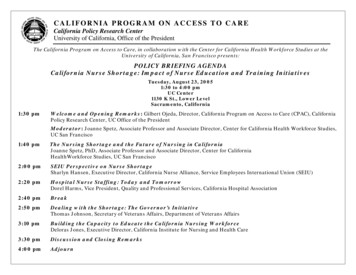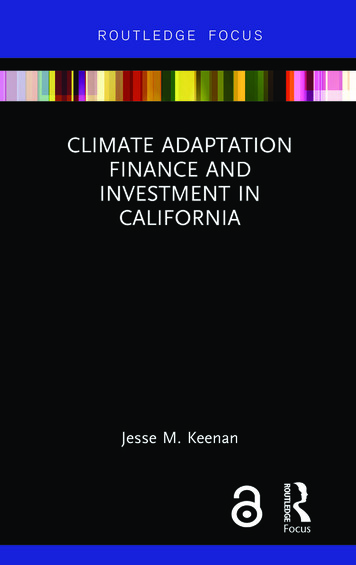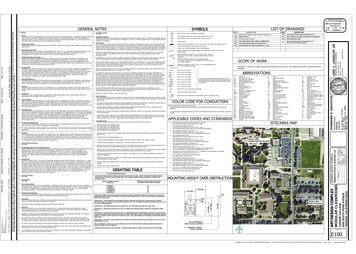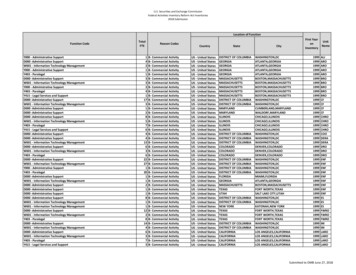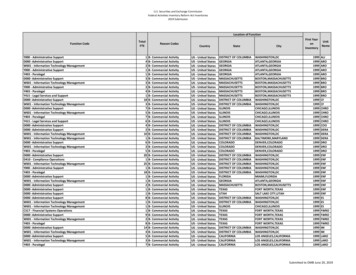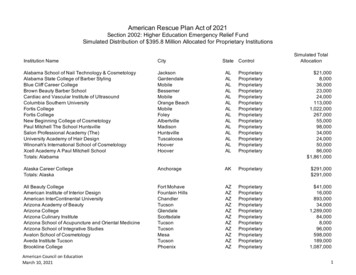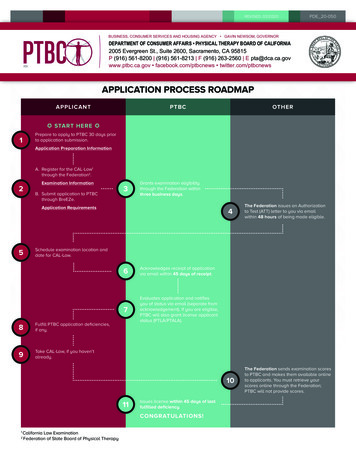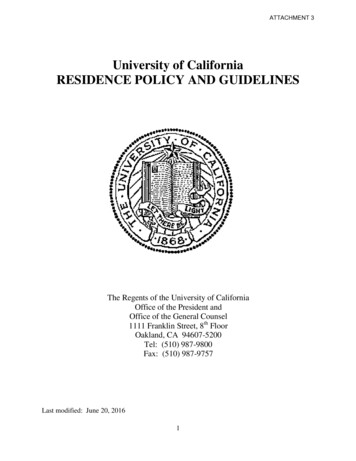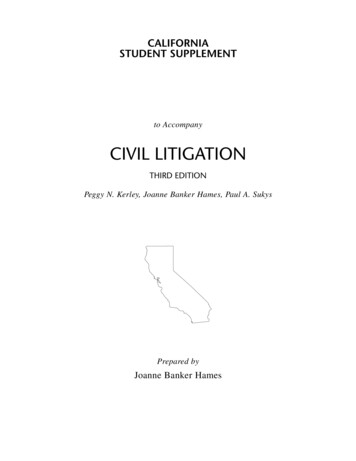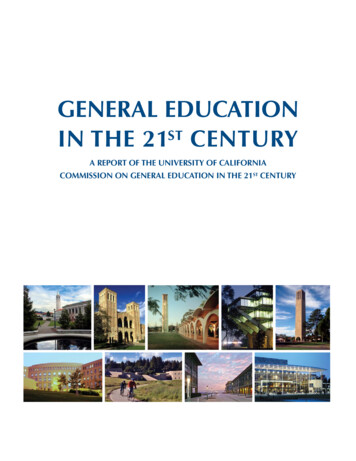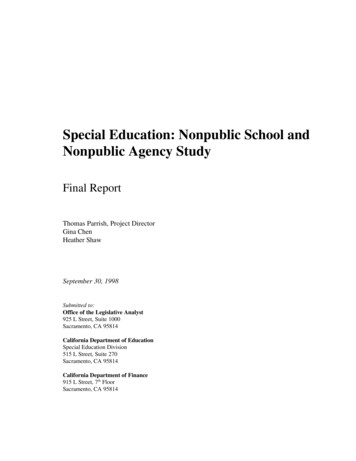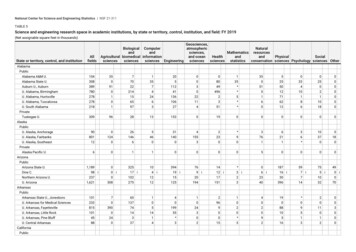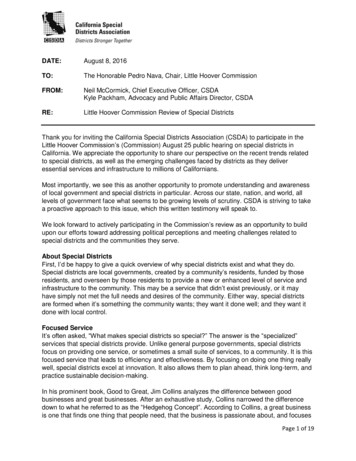
Transcription
DATE:August 8, 2016TO:The Honorable Pedro Nava, Chair, Little Hoover CommissionFROM:Neil McCormick, Chief Executive Officer, CSDAKyle Packham, Advocacy and Public Affairs Director, CSDARE:Little Hoover Commission Review of Special DistrictsThank you for inviting the California Special Districts Association (CSDA) to participate in theLittle Hoover Commission’s (Commission) August 25 public hearing on special districts inCalifornia. We appreciate the opportunity to share our perspective on the recent trends relatedto special districts, as well as the emerging challenges faced by districts as they deliveressential services and infrastructure to millions of Californians.Most importantly, we see this as another opportunity to promote understanding and awarenessof local government and special districts in particular. Across our state, nation, and world, alllevels of government face what seems to be growing levels of scrutiny. CSDA is striving to takea proactive approach to this issue, which this written testimony will speak to.We look forward to actively participating in the Commission’s review as an opportunity to buildupon our efforts toward addressing political perceptions and meeting challenges related tospecial districts and the communities they serve.About Special DistrictsFirst, I’d be happy to give a quick overview of why special districts exist and what they do.Special districts are local governments, created by a community’s residents, funded by thoseresidents, and overseen by those residents to provide a new or enhanced level of service andinfrastructure to the community. This may be a service that didn’t exist previously, or it mayhave simply not met the full needs and desires of the community. Either way, special districtsare formed when it’s something the community wants; they want it done well; and they want itdone with local control.Focused ServiceIt’s often asked, “What makes special districts so special?” The answer is the “specialized”services that special districts provide. Unlike general purpose governments, special districtsfocus on providing one service, or sometimes a small suite of services, to a community. It is thisfocused service that leads to efficiency and effectiveness. By focusing on doing one thing reallywell, special districts excel at innovation. It also allows them to plan ahead, think long-term, andpractice sustainable decision-making.In his prominent book, Good to Great, Jim Collins analyzes the difference between goodbusinesses and great businesses. After an exhaustive study, Collins narrowed the differencedown to what he referred to as the “Hedgehog Concept”. According to Collins, a great businessis one that finds one thing that people need, that the business is passionate about, and focusesPage 1 of 19
on doing that one thing better than anyone else in the world. This is exactly what specialdistricts do in the public sector.Connecting governance, revenue authority, and service delivery is central to the success ofspecial districts. One classic example of bureaucratic wrangling and inefficiency that faceslarger bureaucracies is the governmental department that goes out of its way to spend everylast dime remaining in the fourth quarter so that next year’s budget isn’t raided by the otherdepartments.With special districts, in a sense, the department is the agency. Therefore, service specialistsare empowered to raise and expend revenues toward the services and infrastructure theydeliver. If they can save a buck in the fourth quarter, that’s a buck they can reserve and laterexpend on a valuable innovation or an important long-term capital improvement project—or it’sone less dollar the district will need to raise in fees or taxes in the future.HistoryIn the 1880s, agriculture in the fertile Central Valley was limited to dry farms and low-valuecrops. Local farmers had a desire to tap into the water supply of the Tuolumne River, and thefarmers themselves used their land as collateral to build diversion dams. Over time, it becameclear that a collective, long-term solution was needed.In 1887, the Legislature passed the Wright Act, named after the Modesto attorney who hadbeen elected to office on a pro-irrigation platform. The Wright Act provided the legal foundationfor the formation of water districts and, ultimately, other special districts that now deliver a widerange of services used daily by millions of Californians. The Turlock Irrigation District wasformed the same year, making it the oldest special district in California.The Legislature continued to develop new types of special districts as tools to help residentscome together to solve community problems. Special districts became a popular mechanism forproviding desired community services without the complex bureaucracies that often accompanylarger general purpose governments.For instance, in 1915, the Legislature created mosquito abatement districts because ofwidespread salt marsh mosquitos in the San Francisco Bay and high rates of malaria in ruralcounties. These districts continue to protect the public today from such mosquito bornediseases as West Nile and Zika. Because there weren’t enough hospital beds after World War IIthe Legislature created hospital districts, so that communities could create and manage theirown healthcare and wellness needs. Then in 1994, the Legislature evolved hospital districts intohealthcare districts to meet the growing need for community-based health and wellness servicesand fill gaps in the healthcare delivery system.Throughout California’s history, special districts have empowered residents to find localsolutions to fit the unique needs of their community. It is this local approach that continues tomake special districts a popular method for delivering essential public services andinfrastructure in communities throughout the state.Page 2 of 19
ScaleWhen it comes to the number of special districts, CSDA always emphasizes that the primaryattention should be upon quality over quantity. Ultimately, the residents who receive theservices and fund the services should determine how those services are provided. So it is thequality of service the residents receive for the amount of fees and taxes they are willing to paythat is most important. More simply, it is less about the numbers and more about the residents’needs, the residents’ desires, and the residents’ satisfaction.That being said, we have provided a list of the type and number of independent special districtsbelow in response to the Commission’s request. First, we have listed the number of cities,counties, and school districts for context.While school districts are different than special districts, they are similar in that they provide onespecific service to communities—education. Therefore, school districts offer an importantframework of comparison, from a numerical standpoint, in order to understand the number ofentities it takes to deliver focused service to communities throughout a state the size ofCalifornia. Accordingly, rather than lumping all special districts together, we have broken themout by type of district. While imperfect, this is a more relevant numerical comparison than thecombined total number of all different types of districts.Exhibit A, attached to this letter, is a document entitled, Laws Governing Special Districts. Thisdocument includes the enabling acts and other information related to each type of district listedbelow and will give a better understanding of the roles and services each district type offers.Number of Local Entities:Counties: 58Cities: 482School Districts: 1,022Airport Districts: 10California Water Districts: 132California Water Storage Districts: 8Citrus Pest Districts: 9Community Services Districts: 321Cotton Pest Abatement Districts: 1County Sanitation Districts: 37County Water Districts: 169Fire Protection Districts: 346Harbor Districts: 7Health Care Districts: 79Irrigation Districts: 92Levee Districts: 13Library Districts: 13Mosquito Abatement and Vector Control Districts: 47Municipal Utility Districts: 5Municipal Water Districts: 37Page 3 of 19
Police Protection Districts: 3Port Districts: 5Public Cemetery Districts: 248Public Utility Districts: 54Reclamation Districts: 150Recreation and Park Districts: 95Resource Conservation Districts: 99Sanitary Districts: 66Transit Districts: 17Water Conservation Districts: 13Water Replenishment Districts: 2Veterans Memorial Districts: 27As with cities, towns, parishes, counties, and other jurisdictions, the definition of special districtis not uniform from one state to the next. Nonetheless, the United States Census attempts totrack the number of special districts across the nation. While the Census defines special districtsslightly broader than does CSDA, their definition remains consistent across the 50 states,offering a relevant comparison.Census data from the 2012 Census of Governments indicates that the number of specialdistricts nationwide have grown by 209% since 1962, while the number of districts in Californiahave only grown by 46%. Moreover, the number of special districts in California have declinedby 5% since its peak in 1997, while the number nationwide continued to grow by 10% duringthat same period. Finally, special districts in California make up 7.5% of the nationwide totalnumber of special districts, while the population of California makes up 12% of the nationwidetotal.DensityAccording to the 2012 Census of Governments and 2010 Census Data, California has 13,021residents for each special district. Ranked from most residents per special district (1) to leastresidents per special district (50), California ranks 17.As a measure of “density”, the fewer residents per special district the higher the density ofspecial districts in the state. By this measure, 33 states have a higher density of special districtsper capita than does California. In other words, California is in the 34th percentile, or lowestone-third, in terms of density of special districts per capita among the 50 states.RangeIn terms of the range of special districts, they are as diverse in revenue, staff, and population asthe communities they serve. California is not a one-size-fits-all kind of state, and the needs,hopes, and desires of our communities are wide-ranging. From Modoc to Marin, from Calaverasto Costa Mesa, and from San Francisco to San Bernardino, the climate, topography, socioeconomics, and political settings are simply different. Therefore, it follows that thesecommunities would choose different tools to meet their local service and infrastructure needs.Page 4 of 19
Geographical considerations around a state that includes beaches, deserts, valleys, andmountains have an obvious impact on service needs. However, so does population, economy,and political culture. To generalize, special districts in the more urban areas along California’scoast tend to be larger in nature. They often seek to maximize economies of scale, overcomepolitical boundary lines with regional solutions, and provide innovative solutions to big problems.For example, Metropolitan Water District of Southern California is a regional water wholesalerthat delivers water to 26 member public agencies—ultimately serving 19 million people in LosAngeles, Orange, Riverside, San Bernardino, San Diego, and Ventura counties. To supply themore than 300 cities and unincorporated areas in Southern California with reliable and safewater, Metropolitan owns and operates an extensive water system including: the Colorado RiverAqueduct, 16 hydroelectric facilities, nine reservoirs, 819 miles of large-scale pipes and fivewater treatment plants. In fact, Metropolitan is the largest distributor of treated drinking water inthe United States. It delivers an average of 1.5 billion gallons of water per day to a 5,200square-mile service area.On the other hand, special districts in the more rural areas of inland California tend to be leanerin nature. They often enhance local control so constituents don’t need to drive hours to a distantcounty seat or navigate a larger bureaucracy. Districts in these areas tend to address the limitedneeds of an independent community that appreciates rural living; and they afford residents amechanism to limit the amount of government they must pay for and be governed by.For example, the Pine Cove Water District within the rural Idyllwild mountain community inRiverside County provides retail water service to 1,098 connections. It has no connection toState or imported water because its 18 wells produce between 32 and 43 million gallonsannually. It is known for having reliable, as well as great tasting and excellent quality, water forits residents.In summary, urban special districts more typically serve to centralize and regionalizegovernance of a particular service over a large population or area. Meanwhile, rural specialdistricts more typically serve to localize governance and service delivery for small communities.Neither style of governance is incorrect, they are simply concentrated on the needs and desiresof who they serve.In some parts of the state, communities are transitioning, and it is in these parts where localleadership via a local process is essential to successfully transitioning services that continue tomeet the needs and desires of residents. Some may suggest that the answer to thesechallenges is a top-down approach from the Capitol. However, imposing the views and interestsof Sacramento upon local communities usually hurts more than helps. The most successfulcommunity transitions may involve support from the State, but they must involve buy-in fromwithin, locally. This requires time, intentionality, and local leadership.For example, the residents of Lompico County Water District, in the mountains north of SantaCruz, voted 287 to 74 in May to impose upon themselves an assessment of 48 per month forthe next 10 years in order to fund improvements necessary to consolidate with the San LorenzoValley Water District. This was no easy fete. One year ago, a proposed 30-year bond failed byPage 5 of 19
one vote. Ultimately, the three-year consolidation process garnered community buy-in becauseof local leadership, and Lompico board president Lois Henry was one of those local leaders.When local leaders are empowered to lead a community, true, effective, and sustainabletransformation occurs. When change in local governance and local services is forced from thetop down, it disempowers the local solutions communities need to succeed long-term.May 5, 2016 Lompico Sentinel: Lois Henry, president of the Lompico County Water District board and a Lompico resident for 45years, awaits the merger vote count with fellow board member Rob Hansel, left, and Rick Rogers, on staff of San Lorenzo ValleyWater District (Jondi Gumz -- Santa Cruz Sentinel).Professional DevelopmentOne of the major transformative efforts undertaken following the May 2000 Commission reportwas a coming together of special district leaders to professionalize the special districtcommunity. This effort has grown exponentially every year, with record numbers of attendeesnow going through CSDA’s professional development programs. In 2015, we provided 63workshops, webinars, and conferences representing over 4,239 attendees (elected and staff).By comparison, in 2002 CSDA offered 12 workshops representing 379 attendees (elected andstaff).CSDA Conferences, Workshops, and WebinarsA major component of CSDA’s mission and activities focuses on professional development forelected officials and staff at special districts.The foundation of our governance training efforts is set in curriculum developed by subjectmatter experts and key stakeholders from local government. CSDA’s Special District LeadershipAcademy (SDLA) consists of 4 content modules covering core governance principles andresponsibilities including Governance Foundations, Setting Direction/Community Leadership,Board’s Role in Human Resources, and Board’s Role in Finance & Fiscal Accountability totalingover 20 hours of education. In its first year, 2002, the SDLA saw 34 elected officials go throughPage 6 of 19
the program. Since then, it has consistently grown each year with over 180 elected officialsexpected to graduate through the program just in 2016. The SDLA curriculum is reviewed andupdated annually to ensure it remains current.With an emphasis on promoting the importance of continuing education in districts, CSDAcontinues to grow other program offerings and now offers a wide array of opportunities fordistrict elected officials and staff to stay current on responsibilities, laws, and best practicesthrough workshops, webinars, and conferences. Additionally, on-demand webinars haverecently been added to allow for even greater access to content at lower costs for attendees.A new and promising trend this year has been the development of partnerships beetween twoLAFCOs, Mendocino and Calaveras, with CSDA to deliver free trainings to special districtofficials in their respective counties. These partnerships led to four trainings throughoutMendocino County, including, “Understanding Special District Laws”; “Government BestPractices”; “What is Public Engagement and Why Do It?”; and “Financing Options for SpecialDistricts and Other Local Governments”. One training occurred in Calaveras County, entitled,“Boards Role in Finance and Fiscal Accountability”.Special District Leadership FoundationThe Special District Leadership Foundation (SDLF) is a non-profit 501c3 formed in 1999 topromote and recognize excellence in the governance and management of special districts.Since the Little Hoover Commission’s 1999-2000 review of special districts, significant proactivestrides have been made through the efforts of SDLF and others to promote the visibility andaccountability of special districts. Exhibit B, attached to this letter, is an overview of some ofSDLF’s work. More can be found at www.sdlf.org. There are currently four recognition programsoffered by SDLF: Special District Administrator Certification – Currently 51 Certificate Holders Recognition in Special District Governance – Currently 219 Certificate Holders District Transparency Certificate of Excellence – Currently 118 Certificate Holders Districts of Distinction Accreditation – Currently 32 Accredited DistrictsEach of these programs have specific requirements that must be met in order to earn therecognition with all of them focused on going above and beyond legal requirements through theimplementation of best practices. Nearly all of the programs require periodic renewal in order tomaintain the recognition.In addition to the recognition programs, SDLF has also created a ‘High Performing DistrictChecklist’ that serves as a best practices tool for districts to reference and is specific to theareas of finance and human resources. This is available to all special districts at no cost in printand online with numerous links to other resources to help them implement the best practices.Ultimately, the vision of SDLF is that every special district in California has well-trained,knowledgeable decision-makers and engages the public through a transparent process.Another area of development for SDLF has been providing special districts with professionaldevelopment opportunities that otherwise may not be attainable due to certain cost factors.SDLF has created three different annual scholarship categories that have allowed both electedPage 7 of 19
officials and staff from small districts and disadvantaged communities to attend importanteducational events by covering their registration costs. The scholarships started in 2012 andthis year SDLF expects to award over 40,000 in scholarships.CSDA Member ServicesSince the May 2000 Commission report, CSDA has worked to continually build member accessto tools and resources that will help districts better serve their communities. Throughnetworking, collaboration, and pooled resources, special districts work together more efficientlyand effectively. Some of these services include, but certainly are not limited to: Regular salary surveys. Legal assistance and policy guidance. Library of sample policies and other documents. Request for Proposal clearinghouse Regular informational updates through email, blogs, listserv, and website.Accountability, Visibility, and Public EngagementStreamlineMore and more Californians have come to expect digital access to their local agencies.However, the transition to the digital sphere can be expensive. For this reason, CSDA partneredwith Streamline, a division of Digital Deployment to offer its members a simple, affordable, andhigh quality solution. The Streamline website builder was developed in 2015 with specialdistricts in mind. With no start up fees and no commitment, CSDA members can create andlaunch a website that will meet all legal requirements and SDLF transparency guidelines.Depending on the district’s annual revenue, they may pay as little as 10 per month for theservice, which includes software maintenance and hosting. Additional information can be foundat www.getstreamline.com.CSDA Mapping ProjectIn 2012, CSDA embarked on an ambitious project to develop an interactive map to help raiseawareness of the diversity of special districts. This geographic information system, developed inpartnership with California CAD Solutions, contains location points and boundaries for theindependent special districts in California.CSDA invested a significant amount of time and resources gathering information and data fromall over the state to develop this free resource. More notably, CSDA was able to overlay morethan 90% of boundary lines for all independent special districts in the state. The map isavailable at www.csda.net.CSDA Public Outreach CampaignAs part of its public outreach and awareness efforts, CSDA developed a public outreachcampaign aimed at educating the public about special districts and the services they provide tocommunities throughout the state.The Districts Make the Difference campaign launched in January 2016 using a website-basedplatform that features valuable information and resources regarding the structure, functionality,and purpose of special districts. Informational materials such as videos, posters, factsheets, andPage 8 of 19
infographics have been developed and these are promoted through the use of various socialmedia platforms, including Facebook, Twitter, and YouTube.Access to this campaign, its accompanying materials, and social media pages is available byvisiting www.DistrictsMakeTheDifference.orgILG Public Engagement ProgramThe Institute of Local Government (ILG) is preparing to launch a major new public engagementtool for special districts, cities, and counties. ILG’s Public Engagement Program has receivedgenerous support from The James Irvine Foundation to develop a new public engagementframework that will include example actions and implementation checklists which build uponILG’s existing public engagement resources (publications, tipsheets, webinars) to support localgovernment officials and staff to implement specific public engagement policies and activitiesthat result in systemic changes in resident engagement practices. The current effort will include‘beta-training’ to test the new framework and support local governments in understanding howto implement the policies and practices outlined so challenges and barriers are avoided orovercome and successful implementation is more likely.The overarching goal of the ILG Public Engagement Program is to imbed effective and inclusivepublic engagement practices that encourage data-driven and representative local decisionmaking. To achieve this, ILG will: Encourage more experimentation and use of public engagement and collaboration inlocal communities by elected officials, staff and residents; and Foster greater inclusion of those frequently under-represented in local publicengagement (including impoverished, working poor, immigrants, and renters), throughmore responsive and targeted processes and cross-sector partnerships.ILG Public Engagement Program objectives include: To develop the foundational components of a Public Engagement Actionable Frameworkfor Local Governments, along with companion training curriculum for elected officialsand local government staff to implement the framework; test the framework through twobeta-trainings including communities in the Inland Empire and Central Valley withevaluative follow up to document impact; and develop communication, implementation,and sustainability plans. To develop a public engagement awards program, linked to ILG's Public EngagementActionable Framework to honor outstanding efforts by local governments. To revise internal evaluation systems per recommendations of 2015 evaluationconsultants in order to have more consistent data and improved documentation ofimpact. To continue to promote the importance of civic and public engagement from the local tolegislative levels through promotion of ILG's Public Engagement Program resources andleadership in the California Consortium on Public Engagement.ILG’s mission is to promote good government at the local level with practical, impartial andeasy-to-use resources for California communities. ILG’s program areas include: publicengagement, local government basics, ethics and transparency, sustainable communities, andcollaboration and partnerships.Page 9 of 19
CSDA is a proud partner of ILG and looks forward to supporting and promoting this importantprogram. To learn more about ILG visit, ca-ilg.orgState Mandated Transparency ProgramsIn addition to the voluntary efforts on the part of special districts, significant mandates havebeen placed upon special districts by the California Legislature since the Commission’s lastreview in 1999-2000. Generally, special districts meet similar standards as other local agencies;however, special districts must often exceed the standards for the state and some localagencies:Public Financial Transaction and Compensation ReportsSince 1949, special districts have been required to submit a financial transaction report to theState Controller. However, in 2014, legislation was passed to additionally require completion ofa compensation report, and to require that both the compensation and financial transactionreports be posted or linked to a conspicuous place on each special district’s website. TheController now provides all of this information in an open data format atwww.bythenumbers.ca.gov and www.publicpay.ca.gov.Ethics Training for Board MembersIn 2005, the State enacted legislation mandating special district board members complete atleast two hours of training in general ethics principles and ethics laws.Posting of Board Agendas to WebsiteIn 2012, the State enacted legislation mandating special districts post board agendas to theirwebsites as part of the existing Brown Act open meeting requirements.ElectionsIn 2015, CSDA successfully sponsored changes to Elections Code Section 10404 to empowerspecial districts to move board elections to the same day as statewide general elections ineven-numbered years, as well as provisions to allow for the consolidation of all mail ballotelections conducted by other agencies. Due to upfront costs and potential technologicallimitations, these opportunities to move elections to even years all require the consent of countyelections officials.High Risk Local Agency Audit ProgramIn 2015, regulations went into effect empowering the State Auditor to identify local governmentagencies that are at high risk for the potential of waste, fraud, abuse, or mismanagement, orthat have major challenges associated with their economy, efficiency, or effectiveness. Thus far,the State Auditor identified six cities as potential high risk local government entities, determiningthat two of them, Hemet and Maywood warranted a full State audit.The State Auditor solicited input from CSDA in developing its regulations and the process forthe program. It is our understanding that the Auditor is currently reviewing special districts aspart of its ongoing program.Page 10 of 19
Regular Financial AuditsAlthough a requirement before the May 2000 Commission report, it is important to note thatGovernment Code Section 26909 mandates regular audits of special districts by the countyauditor or a certified public accountant. If the audit is performed by a certified public accountant,the audit must be filed with the State Controller and county auditor.CSDA’s Transparency Policy PrinciplesOn September 5, 2014, CSDA’s Board of Directors approved transparency policy principles. Insummary, CSDA believes districts are made stronger through an engaged and informed public.It is the responsibility of every state and local agency, regardless what service they mayprovide.Statewide policies seeking to promote transparent and accountable governance should do sothrough promoting the following values: Equal Application – Requirements are applied equitably to all levels and types of localand state government, with modifications only to reflect pertinent differences in specificgovernance structures. Uniformity – Information is presented in ways that facilitate comparisons betweendifferent government agencies and levels. Efficiency – Government agencies should be able to carry out transparency efforts withminimal cost impacts to residents, property owners, or taxpayers that could diminishcore service delivery. In addition, policies should not seek to create redundant orduplicative transparency efforts. Accuracy – Information is correct, timely and does not advance misconceptions. Everyreporting agency can clearly understand the information requests and process forreporting. Clarity – Data is shared in meaningful ways that promote greater awareness andunderstanding of governance structures, policies, and/or finances.Efficient and Effective Formation, Reorganizatio
Mosquito Abatement and Vector Control Districts: 47 Municipal Utility Districts: 5 Municipal Water Districts: 37 . Page 4 of 19 Police Protection Districts: 3 . Angeles, Orange, Riverside, San Bernardino, San Diego, and Ventura counties. To supply the more than 300 cities and unincorporated areas in Southern California with reliable and safe .
